Back in the 1970s Sedona had one stoplight and most of the area was still open range. It wasn’t uncommon to wake up and find cattle in your backyard munching on what little grass there was. Just south of Highway 89A at the bridge crossing over Oak Creek, there was a nursery that was home to a distinctive sycamore grove on several acres of land owned by Harry and Ruby Girard.
The Abe Miller Story: Visionary, Developer, Lover of the Arts
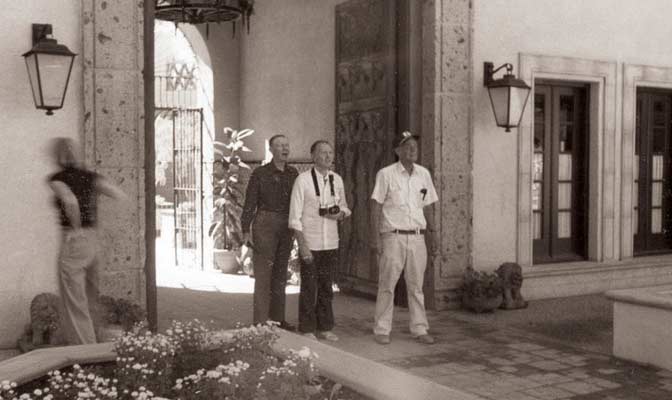
Founder Abe Miller overlooking Tlaquepaque with construction underway
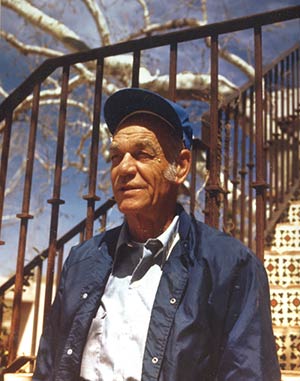
Founder Abe Miller
The conceptual history of Tlaquepaque is truly a story of Abe’s love for beauty and perfection. Under the influence of the lively creative arts scene in Mexico, it struck him that Sedona was a natural location for a living arts community…a village where artisans create in full view of visitors and live on-site as well. It worked in Mexico; it could work here. He called it Tlaquepaque after a colorful Mexican city on the outskirts of Guadalajara by the same name. Tlaquepaque is a word from the Nahuatl Native Indian language, the ancient language of the Aztecs meaning the “best of everything.”
So Abe began a courtship with the Girard’s to acquire the property. It took two years of quiet persuasion and absolute assurances to Harry that the beloved sycamores would remain untouched and healthy. And finally the Girard’s said yes.
Birth of a dream
Immediately, Abe hired Bob McIntyre, a gifted, if unconventional architect, and the adventure began. As the story goes, Bob McIntyre, Abe Miller and Bill Herrick, the general contractor, flew Abe’s plane all over Mexico and ventured into small villages to photograph, sketch, and document the look and feel of the material, their structural components, and their overall flow and design to be interpreted as authentically as possible in their recast Tlaquepaque village. They photographed thousands of scenes from rural villages and sketched dozens of vignettes of Spanish Colonial architecture. They took special note of how the patios, courtyards, tiled walls and plazas created natural gathering places for the villagers to sell their crafts and mingle together.
Transference of culture: Old Mexico comes to Sedona
Bob reported that when he and Abe came upon a small village they would just sit and watch for hours, coming to know the importance of how people, gardens, fountains, and trees shaped social interaction in a public space. They carefully studied the architectural forms, columns and arches, the fine tiled nooks and grand courtyard fountains, stucco walls and intricate ironwork, cobblestone walkways and overhanging balconies. They were soul searching, discovering what life really looked like in rural Mexico, what elements embraced and defined close community.
Like a couple of cultural anthropologists, Abe and Bob began acquiring artifacts reflecting the Mexican culture. Venturing into Mexico on multiple road trips, they scoured villages and markets, purchasing what they intuitively thought would work at Tlaquepaque. Truckloads of iron grillwork, enormous carved doors, handmade lanterns, clay pots and benches came up from Mexico to Sedona on a regular basis…all to create the genuine feel and spirit of Tlaquepaque.
Forget the plumb… use the thumb
Bob McIntyre was an unconventional architect, purposely hiring only amateur artisans and self-trained plasterers, chosen for their heart and enthusiasm for the Tlaquepaque project. He worked right alongside them. No professional stonemasons were on the crew. Tremendous artistic freedom was given to the workers who “loved to be turned loose on a wall and watch it grow under their hands.” And if they weren’t happy with their day’s work, Abe allowed them to tear it down and start over. “Forget the plumb, use the thumb,” was a favorite saying on the construction site.
Very little of Tlaquepaque was sketched out on paper. Abe always allowed his workers a lot of latitude, sometimes as much as plus or minus 24 inches! Everything was eyeballed, keeping the basic orders of columns and capitals, but allowing for many variables. It’s all part of the recipe that gives Tlaquepaque its authenticity and charm.
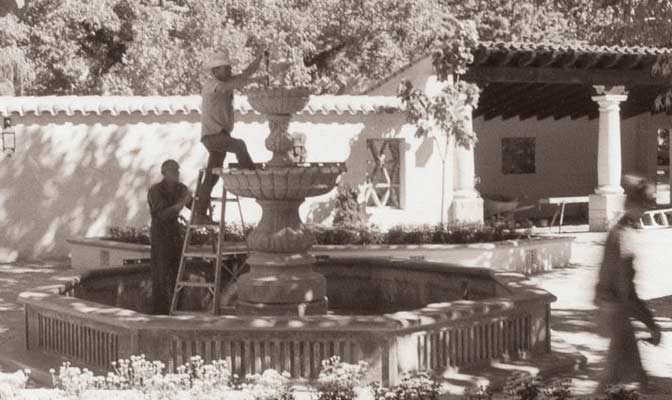
Abe always allowed his workers a lot of latitude…Everything was eyeballed.
Flexibility was the operating principle on the project. Abe’s original notion that artists would work and live in the same complex was soon abandoned when he realized that the Tlaquepaque artists, whom he respected deeply and considered to be pioneers, preferred to keep their living and working space separate.
From the beginning, Abe had a concept, a dream, but he never asked his crew to accept it saying this is the way it has to be. He would wake up each morning, have a cup of coffee, look at what he created the day before and say, “OK. Let’s reevaluate. Maybe we should add this. Maybe we should try that.”
A building that was too symmetrical had no life to Bob McIntyre who said: “Buildings must be built to echo laughter, dancing and singing. Candles, barrels, flickering fires, fountains and flowers are what architecture is all about. I had to explain to Abe and his bankers that we had to line up our arcades and courtyards north and south, the way the old Spaniards did, kitty corner to the prevailing winds. I told them how we wanted simplicity, not austerity–not barren neo-Spanish boxes, but living buildings that are pieces of sculpture.”
When the first phase of construction began in 1971, a building was created just to experiment with the design elements found in Spanish Colonial architecture. Molded concrete forms, ironwork, and arched entryways came together under one roof to see what made artistic sense. Abe had every intention of tearing down the structure once the whole project was completed. In the end he just couldn’t bring himself to do it. It was imbued with too much blood sweat and tears, not to mention investment. Utterly charming, the building ultimately became home to El Rincon Restaurante Mexicano, a Sedona icon for over three decades.
Creating antiquity
The unconventional approaches to architecture and building at Tlaquepaque resulted in a fascinating coming together of tradition and innovation. Thick stucco walls accented with delicate wrought iron, stonework and patterned tiles clearly define space and movement within the village. The entire complex has a natural organic feel that gives one the impression that it has been around for a long, long time.
The Chapel
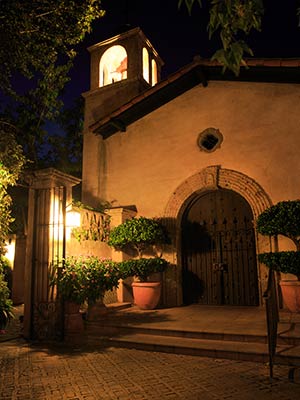
Tlaquepaque Chapel at Night
Inspired Landscaping
Landscaping was a special challenge at Tlaquepaque. Abe’s promise to Harry Girard was that the beautiful sycamore grove would always remain untouched. So as structures went up, they were built around the tall sycamores. At great cost in labor and materials all plans were modified to incorporate the trees’ natural form. So today you will find huge sycamore limbs merging with rooflines, growing through massive walls and even up through an art gallery. Inside the Rowe Fine Art Gallery a magnificent sycamore
twists skyward through the roof.
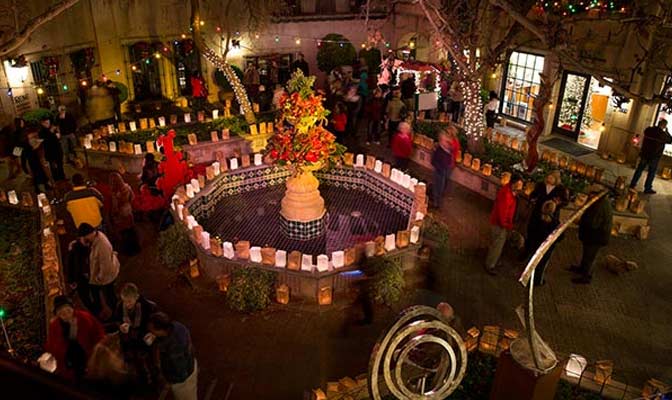
Fountains are seasonally decorated with fantastic floral creations.
Tlaquepaque was, from the beginning, awash in flowers and brilliant colors. A greenhouse nurtured thousands of potted flowers, which were rotated seasonally. Abe loved the vibrant gardens and began a tradition that has expanded to a grand scale today, filling Tlaquepaque with a palette of ever-changing hues throughout the seasons.
Today, after years of growth, Tlaquepaque is graced with climbing vines of sweet scented honeysuckle, purple clematis, ivy trumpet vine and silver lace. Pansies are everywhere in early spring and remain until late April when the Arizona sun becomes too strong. Summer at Tlaquepaque is bedecked in rainbow colors around every corner. Fountains are seasonally decorated with fantastic floral creations in celebration of one of the many year round fiestas, weddings or private events.
Legacy
Often the measure of a person is how they connect with others in everyday life. Abe was known for his humility. It was quite common to see Abe in blue jeans, a workshirt and his signature baseball cap just walking the property. He totally downplayed his role at Tlaquepaque. Abe didn’t just tell people what to do. He would help them and work right alongside them. He was quick to give credit to others rather than keeping it for himself.
“This is such a great place, and Abe was a wonderful man with a huge vision. He created Tlaquepaque as a labor of love and it shows. It was not a commercial venture, which made it incredibly special. If you ask me how to describe Abe, I would tell you that you need to read the words on the plaque which hangs on the Chapel that says: “Some men only dream. Others make dreams come true.”

Wendy Lippman
Resident Partner & General Manager
Phone:
(928) 282-4838
Email:
visitorinfo@tlaq.com





